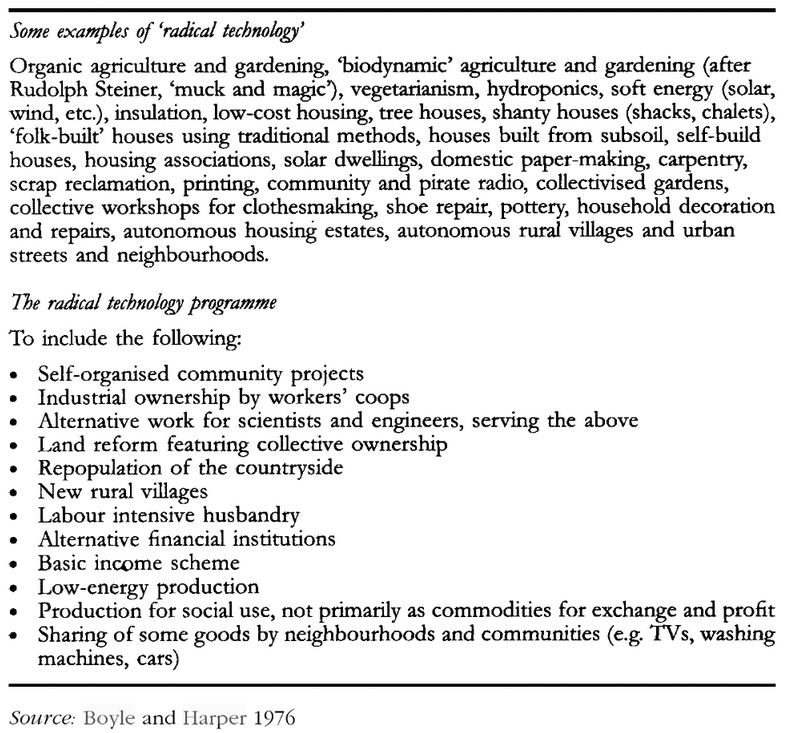Radical Technology: Difference between revisions
No edit summary |
m (inserted a few links) |
||
| Line 8: | Line 8: | ||
The articles in the book range from detailed 'recipes' through general accounts of alternative technical methods, to critiques of current practices, and general proposals for reorganisations. Each author has been encouraged to follow her or his own personal approach, sometimes descriptive, sometimes analytic, sometimes technical, sometimes political. The contributors are all authorities in their fields. | The articles in the book range from detailed 'recipes' through general accounts of alternative technical methods, to critiques of current practices, and general proposals for reorganisations. Each author has been encouraged to follow her or his own personal approach, sometimes descriptive, sometimes analytic, sometimes technical, sometimes political. The contributors are all authorities in their fields. | ||
The book is divided into seven sections: Food, Energy, Shelter, Autonomy, Materials, Communication, Other Perspectives. Over forty separate articles include items on fish culture, small-scale water supply, biological energy sources, a definitive zoology of | The book is divided into seven sections: Food, Energy, Shelter, Autonomy, Materials, Communication, Other Perspectives. Over forty separate articles include items on fish culture, small-scale water supply, biological energy sources, a definitive zoology of thew indmill, selfhelp housing, building with subsoil, making car-type shoes, the economics of autonomous houses, what to look for in scrap yards, alternative radio networks, utopian communities, and technology in China. Between the main sections are interviews with prominent practitioners and theorists of Radical Technology, including [https://en.wikipedia.org/wiki/John_Todd_(biologist) John Todd] of the [https://en.wikipedia.org/wiki/New_Alchemy_Institute New Alchemy Institute]; [https://en.wikipedia.org/wiki/Robert_Jungk Robert Jungk], author of Humanity 2000; the Street Farmers, a group of anarchist architects; Peter van Dresser, and Sietz Leefland, editor of Small Earth, the Dutch journal of alternative technology. | ||
Also included between the main sections of the book is a series of visionary drawings by the gifted illustrator [https://en.wikipedia.org/wiki/Clifford_Harper Clifford Harper], evoking the spirit and practice of Radical Technology: How it could be. These drawings, or 'visions' include a communalised urban garden layout; a household basement workshop; a community workshop; a community media centre; a collectivised terrace of urban houses; and an autonomous rural housing estate. | Also included between the main sections of the book is a series of visionary drawings by the gifted illustrator [https://en.wikipedia.org/wiki/Clifford_Harper Clifford Harper], evoking the spirit and practice of Radical Technology: How it could be. These drawings, or 'visions' include a communalised urban garden layout; a household basement workshop; a community workshop; a community media centre; a collectivised terrace of urban houses; and an autonomous rural housing estate. | ||
| Line 17: | Line 17: | ||
*If you want to read the original Radical Technology book, a slightly grainy microfiche version can be downloaded [http://www.fastonline.org/CD3WD_40/JF/409/01-13.pdf here]. (internal copy: [http://opensourceecology.org/wiki/File:RadicalTechnology_-_microfiche.pdf here]). | *If you want to read the original Radical Technology book, a slightly grainy microfiche version can be downloaded [http://www.fastonline.org/CD3WD_40/JF/409/01-13.pdf here]. (internal copy: [http://opensourceecology.org/wiki/File:RadicalTechnology_-_microfiche.pdf here]). | ||
*No Tech Magazine [http://www.notechmagazine.com/2016/07/radical-technology-revisited.html "Radical Technology Revisited"] | *No Tech Magazine [http://www.notechmagazine.com/2016/07/radical-technology-revisited.html "Radical Technology Revisited"] | ||
*[https://www.amazon.com/Radical-Technology-Materials-Communication-Community/dp/0394730933 Used on Amazon.com] | |||
Revision as of 00:15, 11 July 2016
Book: "Radical Technology - Food and Shelter, Tools and Materials, Energy and Communications, Autonomy and Community" (1976). Edited by Godfrey Boyle and Peter Harper, and the editors of Undercurrents.
Summary
Radical Technology is a large-format, extensively illustrated collection of original articles concerning the reorganisatipn of technology along more humane, rational and ecologically sound lines. The many facets of such a reorganisation are reflected in the wide variety of contributions to the book. They cover both the hardware - the machines and technical methods themselves - and the 'software' - the social and political structures, the way people relate to each other and to their environment, and how they feel about it all.
The articles in the book range from detailed 'recipes' through general accounts of alternative technical methods, to critiques of current practices, and general proposals for reorganisations. Each author has been encouraged to follow her or his own personal approach, sometimes descriptive, sometimes analytic, sometimes technical, sometimes political. The contributors are all authorities in their fields.
The book is divided into seven sections: Food, Energy, Shelter, Autonomy, Materials, Communication, Other Perspectives. Over forty separate articles include items on fish culture, small-scale water supply, biological energy sources, a definitive zoology of thew indmill, selfhelp housing, building with subsoil, making car-type shoes, the economics of autonomous houses, what to look for in scrap yards, alternative radio networks, utopian communities, and technology in China. Between the main sections are interviews with prominent practitioners and theorists of Radical Technology, including John Todd of the New Alchemy Institute; Robert Jungk, author of Humanity 2000; the Street Farmers, a group of anarchist architects; Peter van Dresser, and Sietz Leefland, editor of Small Earth, the Dutch journal of alternative technology.
Also included between the main sections of the book is a series of visionary drawings by the gifted illustrator Clifford Harper, evoking the spirit and practice of Radical Technology: How it could be. These drawings, or 'visions' include a communalised urban garden layout; a household basement workshop; a community workshop; a community media centre; a collectivised terrace of urban houses; and an autonomous rural housing estate.
The book ends with a comprehensive directory of the literature and active organisations in Radical Technology. This notes inevitable gaps in the book's coverage, points the reader to where more information can be found, and provides also an overall picture of a growing movement.
Links
- If you want to read the original Radical Technology book, a slightly grainy microfiche version can be downloaded here. (internal copy: here).
- No Tech Magazine "Radical Technology Revisited"
- Used on Amazon.com
